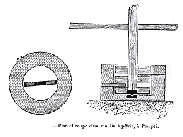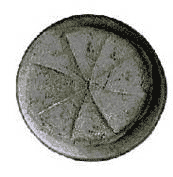 |
[ZAWiW] [gemeinsamlernen] [LiLL] | ||
|
|
|
|
| home | ||
|
|
Gallo-Roman Bread | |
 |
||
Gallo-Roman Bread
Stand:The kneading of the dough had a spectacular improving at Rome, at least by
the most prosperous bakers : a cylindrical stone vat was realised, in which a
wooden arm was turning due to a mechanical system, moved by a horse or slaves.

Plan and design of kneading mill at Pompeï
The Roman bread is generally round, with different designs on top. The bakers
were excellent in imagination and made bread in all types of figures on demand.
During the feast, the bread in a shape of a lyre, different birds or even
obscene forms of human members, were most appreciated.
In the composition of the dough, sometimes were added :
- white grease
- honey
- eggs
Also fruits were used, like :
- figs
- palms
- jujube
In the form of a “ sugar girdle-cake “, a marmalade of dates or honey was added.
When eating hot, they were light and easy to digest.

Round-loaf of one pound with 8 flower petals
( found carbonised on the ruins of Pompeî )
Some different sorts of bread
- Bread of finest wheat flour, SILIGECES, with a soft crumb for patricians.
- Bread of very ordinary mixed flours for plebeians.
- Bread for oysters OSTREAIUS, MILITARIS for the army.
- Bread of PICENUM with dried raisins, puffed by honey milk.
- Placenta, made leaf by leaf stretched with cheese and honey
- ( like the arabian Pastilla)
- The CONFARREATIO, wending-cake with flour of “épeautre, which was offered
to Jupiter Capitoli, etc...
